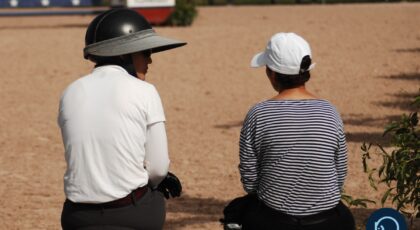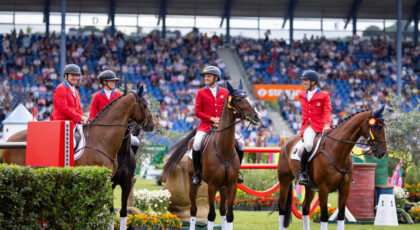Candice King is in a plank position in the middle of the barn aisle, and she’s counting off pushups.
It’s been two days since her cousin encouraged her to take up the “22 Pushup Challenge,” completing 22 pushups a day for 22 days in order to raise awareness for the 22 veterans who commit suicide on average every day in America.
King is on “break” between groups at her three-day October clinic at Hawk Hollow Farm in Erieville, New York, where’s she’s running five sessions a day to groups of three to five riders. All of the clinic’s proceeds are being donated to the Heart Run/Walk Teams of Alex Hastie and judge Leo Conroy—so Candice King is essentially doing charity pushups for one cause while volunteering her time at another charity’s riding clinic. She chuckles at this irony but shrugs off the implication that it’s something out of the ordinary.
“My parents have always been genuine, sincere people about life, and quality of life. You work hard and things come back to you. The horse industry has been very good to me, I’ve had a lot of success. I’ve had to work hard, but also I’ve had a lot of help, so for me to give back and help others, that’s just how I was raised,” she says.
King has had a long and distinguished career in the show jumping world, having represented the U.S on numerous Nations Cup and Super League Teams. In 2001, she was the top-placing American rider at the World Cup Final in Gothenburg, Sweden aboard John E.M., and she became the first American in 30 years to win the Queen Elizabeth II Cup at Hickstead in England.
The 2015 show year was particularly successful for King and the Bellissimo family’s Kismet 50, earning back-to-back Nations Cup wins with the Hermès U.S. Show Jumping Team, first in February at the CSIO4* at WEF, and again at the CSIO4* in Coapexpan, Mexico in April. King and “Betty” also finished fourth as the highest-ranked American pair at the CSI3* Central Park Horse Show in September 2015, before she and the Bellissimos made the mutual decision to retire the 15-year-old mare, who is currently in foal in Europe.
“She had gone above and beyond and had really done more than we all expected,” says King, who calls Betty one of the most important horses of her life. “She really was my partner and my best friend.”
As a young girl growing up in San Fernando Valley, California, King’s parents Al and Marlo Schlom owned Quarter Horses and were active on the local roping and cutting circuits. King took her first trail ride with her mother at just six months of age and was showing in halter classes by the time she was three. At age five, she says, she would sometimes be allowed to work a calf in the arena at the end of a cutting show, but she was still too young to ride in any actual classes.
Had things been different, we might today know Candice King the rodeo queen, not Candice King the show jumper. But fate had other plans.
“I’ve had to work hard, but also I’ve had a lot of help. so for me to give back and help others, that’s just how I was raised.”
“I was too little to compete, and I didn’t like the halter and the western pleasure and the trail classes because they were too boring,” she recalls. “So when I was about six, my parents had a lot of old cowboy and horsemen friends, so they let me take my mother’s Quarter Horse to start having English lessons with one of them.”
King first learned to jump on Penny Lane, her father’s top cutting horse, and says she “never looked back.” But many of those early lessons learned in a western saddle stay with her even today.
“A lot of skills translate from cutting to show jumping: my balance, a lot of riding off the leg and the seat,” she says, adding that many people mistakenly assume that her deep-seated style comes from training in Europe.
By age 14, King and her Appaloosa gelding Chocolate Mousse were making a name for themselves at Devon, the Washington International, and other top shows on the East Coast. A photograph of the duo jumping a six-foot puissance wall even made the cover of a 1985 issue of Horses magazine.
The Schloms supported their daughter’s bi-coastal junior career while King made her way through the ranks on a combination of hard work and talent. She took a working student position to pay for lessons with Frank Madden and Bill Cooney at Beacon Hill in New Jersey, and regularly accepted rides on mounts that took a little extra time or patience.
These traits would become hallmarks of King’s career, beginning with her debut on the American Grand Prix Association circuit at age 19.

King riding Skara Glen’s Davos at the Meydan FEI Nations Cup in Aachen, 2010. (Courtesy of Candice King)
“I’ve had some young green horses and difficult horses because my parents—we didn’t come from big means—so I always had to have something that either needed time or needed the right positive kind of ride,” she explains.
“It was very rewarding to bring a horse along that I’d developed, or a student that was maybe timid, or who started in the children’s jumpers and is now riding in the Grand Prix. I take it as part of what we’ve done as a team because I always believe there’s no ‘I’ in team. It’s a gratifying progression, just being a part of it.”
“that dark secret of all the longing and the medicating—People are too quick to try and get the horses to the ring now because they don’t want to spend their time at home doing what they should be doing.”
In fact, King told the audience in her Hawk Hollow clinic, she is changing the nature of her own business to focus more on training young horses—six of whom have already graduated from King’s program and gone on to compete at the Olympic level. King’s personal frustration with the industry is behind the shift. Too many talented prospects, she says, aren’t reaching their full potential because owners and trainers are embracing shortcuts to get them into the ring sooner and to see winning results faster.
“It’s a big problem in our horse show world, that dark secret of all the longing and the medicating. People are too quick to try and get the horses to the ring now because they don’t want to spend their time at home doing what they should be doing,” says King, adding that a similar pattern can be found in how the country’s young riders are trained.
“I think the American riding system could be a little stronger in its character of horsemanship, for sure. There’s been a regression from getting on, knowing your horse, and being able to work it out at home. I think a lot of horses are prepared for the rider, and the rider is just put on there, so when any diversity comes, I feel like there’s a lack of depth and of knowing that they can do it themselves.”
“A big part of it is this right here,” she says, holding up her cell phone.
“For me, I think, society has gotten really weak. Everybody just wants to press a button and have an answer. They don’t have to drive anywhere, they don’t have to look up where the book is…you just Google it, and it’s instant. So now I think people just want to watch a video and think that the next day, they’re going to fix their problem. Horses aren’t that way. They have feelings. They have their own ways of doing things.”
During almost every session of her three-day clinic, King chose a different horse in the group to ride. Usually, it was the horse being difficult in a particular exercise. Over three days, she sat on everything from off-the-track Thoroughbreds and imported Warmbloods to cranky school horses and even a small green pony. In one case, she took off a young horse’s bridle and jumped him over a course of low jumps with just a rope around his neck, illustrating how little tack is really needed when a horse is trained properly.
In all case, the rides King demonstrated were instructive, if not all of them were pretty. Many of the horses were upset at suddenly being called out on longtime bad habits, or for trying to cow their riders with their antics. Some backed up, leaped in the air or spun in circles. One tried his hardest to rear.
“I don’t expect you to be able to get back on and do this,” she called to one rider who was waiting in the middle of the ring while her horse threw a tantrum with King aboard. “That’s why I’m on here.”
All of the horses had improved when King was done with them, and most were able to complete the day’s exercises. But none were instant fixes. One horse would need to be retrained to accept the leg. Others who finally exhibited some signs of flexion with Candice in the tack would likely take months, or even years, to get to the same point with their owners.
But if there’s one lesson that the more than 150 riders and auditors in attendance walked away with, it’s that there’s no magic bullet for horsemanship. Horsemanship requires time and consistency. It takes dedication, work, and lots of patience. It doesn’t always end in blue ribbons.

Candice and her dog Thumper. (©James Hastie)
At the end of the weekend, Candice King’s Hawk Hollow Clinic had raised more than $5,000 for the memorial Heart Walk Team of Alex Hastie and Team Leo Conroy. As an added bonus, King also completed her three days worth of push-ups as part of the 22 Pushup Challenge.
As it turns out, that’s a lot of pushups when you’re not used to doing them, and perfect form takes time and strength to develop. But Candice King, banging out the day’s set in front of a small crowd at her own clinic, was undeterred. She still had plenty of time left to get them right.
“They’re girl ones now,” she called out breathlessly between numbers, “but they’ll get better each day.”


 November 1, 2016
November 1, 2016 

























